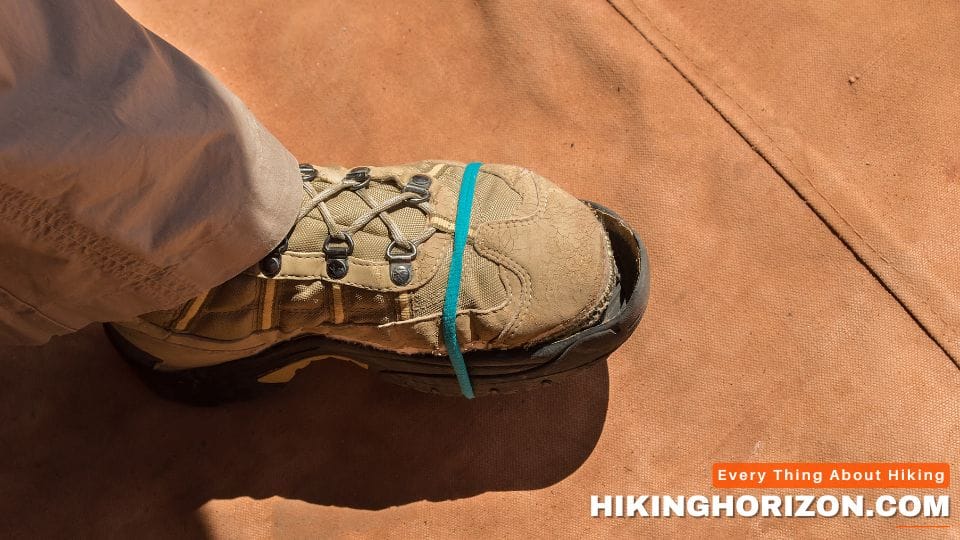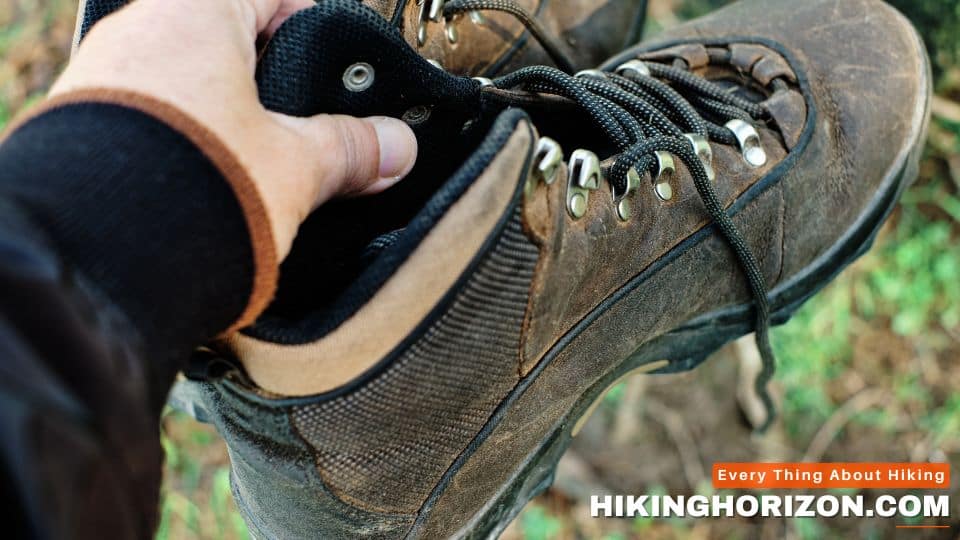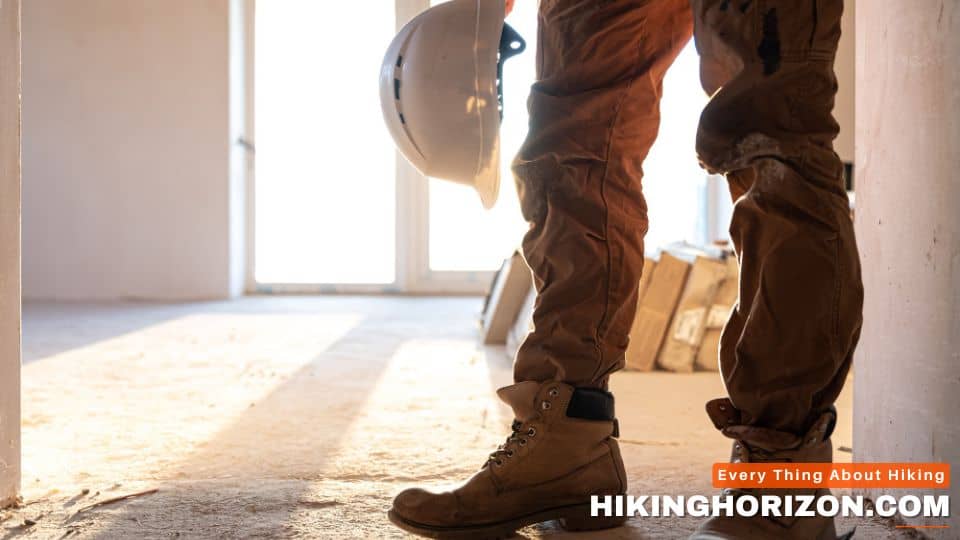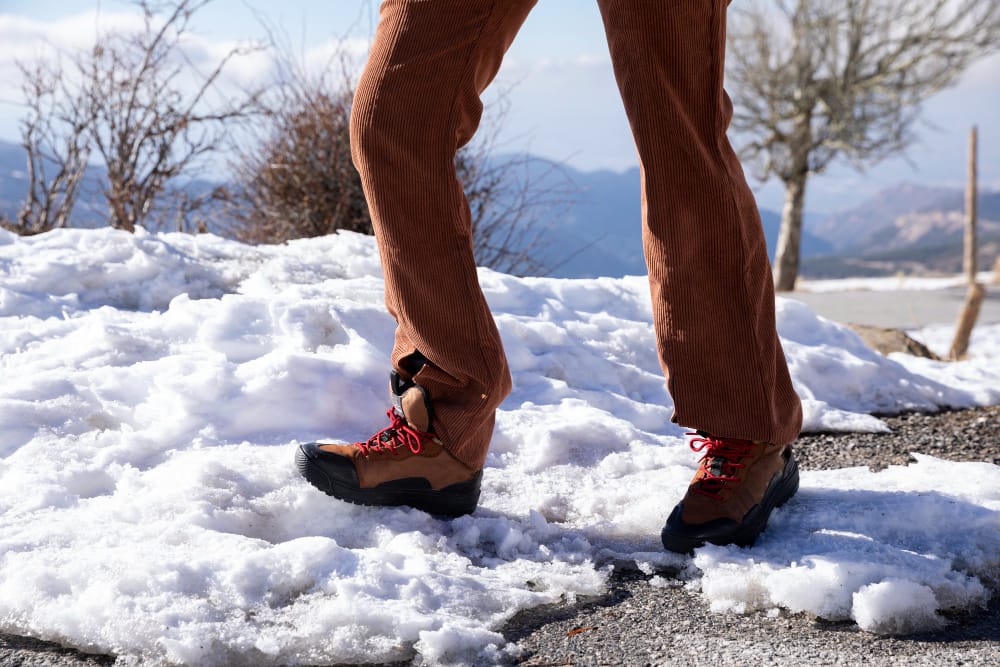
Hiking boots are an essential piece of equipment for hikers, but they can also be quite expensive. When your hiking boots start to wear out, tossing them and buying a new pair can be tempting. One question that many hikers have is whether or not their hiking boots can be resoled. The short answer is yes, hiking boots can be resoled, but it depends on several factors.
However, resoling your hiking boots can be a cost-effective way to extend their lifespan and save money in the long run. In this guide, we’ll explore whether hiking boots can be resoled, how to do it, and what you need to know to make the process successful.
Table of Contents
What is resoling?
Resoling is replacing the worn-out sole of a shoe with a new one. It is done by removing the old sole and attaching a new one to the bottom of the shoe. While this may sound simple, it is a complex process requiring skill and expertise.
Can Hiking Boots Be Resoled?
The answer is yes; hiking boots can be resolved. But it depends on the construction and design of the specific boots. Many modern hiking boots and shoes cannot be resoled due to how they are manufactured, often with components glued or molded together to prevent sole replacement.
However, hiking boots with cemented or double-stitched construction can typically be resoled. This type of construction joins the upper boot, insole, and outsole in a way that allows them to be separated for resoling. Boots with a Strobel stitch design are harder to resole since the sole is essentially sprayed on and bonded to the upper. At most, the heel portion may be replaced.
Before resoling, check with the boot manufacturer to see if they offer resoling services or have warranty policies about sole wear. Some brands will replace boots within a certain timeframe or offer discounts on new pairs. Independent cobblers specialize in hiking boot repair and can resole them if the construction allows it. Just be aware of any mailing costs for using a remote service.
With boots made of quality leather or suede that have resolable construction, paying to have new soles installed can extend their life at a fraction of the replacement cost. But the design and build of the boot ultimately determine whether resoling is an option.
"Your hiking boots may be worn, but they are a testament to the miles you've traveled and the memories you've made."
Can All Hiking Boots Be Resoled?
The ability to resole hiking boots depends on the construction of the boots. Generally speaking, hiking boots that are welted or stitched can be resoled, while those that are glued cannot.
Welted Or Stitched Boots
These types of boots have a strip of leather, rubber, or other material sewn to the upper part of the boot, which is then attached to the sole. This construction method allows the sole to be easily removed and replaced without damaging the upper part of the boot.
Glued Boots
On the other hand, glues boots have the sole attached to the upper part of the boot with an adhesive. It means that the sole cannot be easily removed without damaging the upper part of the boot, making it difficult or impossible to resole.
What if you only replace the upper of your hiking boots?
When it comes to hiking boots, the upper and the sole work together as a solid unit to provide support and traction on the trail. Leather boots designed specifically for backpacking and hiking can be resoled and repaired to extend their life. If your favorite hiking boots are still in good shape except for a worn-out sole, getting them resoled with Vibram or another durable material is often a viable option to make them as good as new.
However, trail runners and lightweight hiking shoes that are made mostly of mesh and synthetics often can’t be resoled. When the tread wears down on those trail shoes or running shoes, it’s time to replace the whole footwear.
If your hiking boots would benefit from new uppers, it may be worth investing in a whole new pair of boots that are a perfect fit for your hiking needs. Consider looking for a high-quality set of boots online or at an outdoor gear store. Make sure to get your boots from a brand that has a repair service to resole and refresh them when eventually needed. Putting money into a solid new pair of leather hiking boots means they can be resoled and keep you moving on the trail for years to come.
How To Determine If Your Best Hiking Boots Can Be Resoled

Look for Visible Signs of Wear and Tear
Before you decide to have your hiking boots resoled, it’s important to determine if they are in good enough condition to be repaired. One of the first things you should do is look for visible signs of wear and tear. Check the soles of your boots to see if they are worn down, cracked, or have any other damage. If the soles are severely damaged or holes in the upper part of the boot, it may not be worth the cost to have them repaired.
The Condition Of Upper
Another factor to consider when resoling hiking boots is the upper condition. If the upper is in good condition, resole the boots may be worth the investment. However, if the upper is showing signs of wear, it may be time to invest in a new pair of hiking boots.
Check the Quality of the Boots
Another important factor to consider when determining if your hiking boots can be resoled is the quality of the boots themselves. Higher-quality hiking boots are usually made with better materials, which means they are more durable and can withstand more wear and tear. If you invested in a high-quality pair of hiking boots, having them resoled might be worth it instead of buying a new pair.
Consult with a Professional Shoe Repair Shop
If you’re unsure if your hiking boots can be resoled, it’s always best to consult with a professional shoe repair shop. A trained professional can inspect your boots and determine if they can be repaired. They can also provide an estimate of the cost of repairing your boots, which can help you decide if it’s worth the investment.
How Much Does It Cost To Resole Walking Boots?
The cost to resole hiking boots can vary depending on a few factors but typically ranges between $40-80.
Here are some of the pricing considerations:
- Cobbler Location – Resoling prices can differ based on where you get it done. Larger cities tend to be more expensive.
- Level of Repair – A simple tread replacement is cheaper than a full resole. Some cobblers charge by the hour.
- Boot Material – Delicate leathers and suedes take more time and care to resole, increasing cost.
- Added Customization – Upgrades like lug enhancements, toe/heel caps, or crampon mounts increase the price.
- Shipping Fees – If sending boots out for resoling, shipping/insurance costs need to be factored in.
- Expedited Service – Rush orders usually come with an upcharge. The typical turnaround is 1-2 weeks.
- Brand Name – Some brand-specific services, like Danner’s Recrafting, run $125-150 due to the first-class materials used.
While the pricing can vary, the average cost hovers around $60-70 for a typical hiking boot resole. At 1/3 the cost of new boots, it extends the life affordably. Considering local cobblers and basic resoling instead of upgrades keeps costs down. For the best value, resole boots before the tread is completely gone.
Can I Replace The Midsole or Insole?
It is possible to replace just the midsole on a hiking boot rather than the entire outsole. Here are some tips on replacing midsoles:
- Midsole Purpose – The midsole provides cushioning and shock absorption. Replacing a compressed midsole restores comfort and support.
- When to Replace – Replace midsoles when they feel flattened or compressed, causing foot pain and soreness. It usually occurs every few years with heavy use.
- Removal Process – A cobbler will carefully peel away the worn midsole layer from the rest of the outsole. It leaves the remaining sole intact.
- Midsole Options – New midsoles come in materials like EVA foam or polyurethane. Pick what matches your comfort needs.
- Expert Fitting – The cobbler will custom fit and adhere the new midsole to the boot’s shape for optimal performance.
- Cost – Only replacing the midsole rather than the full resole saves money. Midsole-only replacements average $30-50.
Focusing just on the cushioning midsole layer extends the life of boots at a lower cost than a full resole. It restores foot comfort when interiors feel worn without changing the whole tread. Discuss options with your local cobbler when cushioning needs replenishing, but uppers are still solid.
When Does Resoling Cost Too Much?
Determining when the cost of resoling hiking boots is too much depends on a few factors:
- Boot Age – If boots are very old with excessive wear, a resole may cost more in repairs than just buying new boots. The uppers may not be worth salvaging.
- Upper Condition – Heavily damaged uppers like cracked leather or separating seams can require added repairs beyond just resoling, increasing cost.
- Previous Resoles – Multiple resolings drive up lifetime costs. At some point, investing in new boots makes more sense.
- Cobbler Skill – An inexperienced cobbler may charge less but do poor work requiring re-resoling and added costs.
- Resole Price – If the quote is more than about half the cost of new boots, the price is likely too steep.
- New Boot Features – New technologies and features in modern boots may make replacement more beneficial than resoling dated boots.
- Other Repair Needs – Needing other fixes like new liners, laces, hooks etc. on top of resoling can add up quickly.
Experts recommend replacing hiking boots rather than resoling them if the resole cost exceeds 40% of the price of new boots. While resoling can modestly extend the life of boots, it does not compare to the longevity of brand-new footwear.
At a certain point, the more cost-effective option is to invest in a fresh pair of boots that will last you many miles rather than sinking money into an old pair with limited mileage left. If your cobbler quotes a resoling fee close to half of new boot prices, it’s likely time to shop for replacements.
How Often Should You Resole Hiking Boots?
The frequency of needing to resole your hiking boots depends on usage and terrain, but a good rule of thumb is every 300-500 miles of wear. For moderate hikers, this equates to resoles every 2-6 months.
Dry Terrain
Hiking primarily on dry, rocky surfaces leads to faster tread wear from abrasion. Boots worn often on these conditions may need resoling 1-2 times per year, assuming quality, durable footwear.
Wet Terrain
Wet terrain quickens the need for resoling due to moisture deteriorating boot components. The constant exposure to water weakens glue and stitching at a faster rate. Boots worn routinely in slippery, muddy, or flooded conditions might require resoling every 2-3 months and multiple times annually.
Boot Construction
Boot construction also impacts longevity between resoles. Premium leathers and synthetics hold up better than lower-grade materials. Skilful stitching and adhesion create a more water-resistant barrier. High-end boots from reputable outdoor brands generally outlast cheaper versions, extending the mileage between necessary resolings.
Consider your typical hiking terrain and mileage, boot quality, and visible tread wear when gauging the optimal timing for maintenance through professional resoling. It preserves the safety, traction, and comfort of broken-in boots you love to hit the trails in.
How Long Do Resoling Hiking Boots Take?


On average, resoling hiking boots can take a few days to a few weeks. This timeline may also depend on the workload of the shoe repair shop and how many other shoes are in line for repairs.
The time it takes to resole hiking boots can vary depending on several factors.
Hiking Boot And Sole Material
Firstly, the type of hiking boot and sole material can affect the time it takes to resole them. Boots with thicker and more complex soles typically take longer to resole than those with simpler soles. Additionally, the type of material used for the new sole can also impact the time it takes to complete the resoling process.
Availability Of Materials
Another factor affecting the time it takes to resole hiking boots is the availability of materials and resources. If the cobbler or shoe repair shop doesn’t have the necessary materials, it may take longer to order and receive them.
Benefits of Resoling Your Hiking Boots


Cost-Effective Solution
One of the main benefits of resoling your hiking boots is that it’s a cost-effective solution. Instead of spending money on a new pair of boots, you can repair your current boots for a fraction of the cost. It is especially beneficial if you have a high-quality pair of hiking boots you’re not ready to part with.
Eco-Friendly Option
Another benefit of resoling your hiking boots is that it’s an eco-friendly option. By repairing your boots instead of throwing them away and buying a new pair, you’re reducing the amount of waste that ends up in landfills. It is an excellent way to reduce environmental impact and be more sustainable.
Maintains the Fit and Comfort of Your Boots
When you break in a new pair of hiking boots, they mold to the shape of your feet. It creates a custom fit that is both comfortable and supportive. It can be uncomfortable and time-consuming if you have to break in a new pair of boots every time your old ones wear out. Resoling your hiking boots allows you to maintain the fit and comfort of your boots while extending their lifespan.
"Life is full of ups and downs, just like a hike, but the view from the top makes it all worthwhile."
Pros and Cons of Resoling Hiking Boots

Here are the pros and cons of getting your hiking boots resoled:
Pros:
- Cost Savings: Resoling boots costs $40-80, much less than purchasing a new pair which can run $150-300. It extends life at a fraction of the price.
- Waste Reduction: Resoling is environmentally friendly, reducing waste from discarded boots. It cuts down on raw materials and manufacturing impacts.
- Customization: Cobblers can replace the sole with your choice of tread type and pattern to match your hiking needs.
- Preserve Fit: Getting another season or two out of beloved, broken-in boots that fit your feet perfectly has great value.
- Quick Turnaround: Most resoling services take 1-2 weeks, allowing you to get boots back promptly. Some offer expedited services.
Cons:
- Sole Limitations: Boots can only be resoled a finite number of times before uppers degrade. Synthetics may only allow one resole.
- Quality Variance: Resoling quality depends on the specific cobbler’s skill and craftsmanship. A bad resole can damage boots.
- Upfront Cost: The resoling cost comes all at once versus being spread out through a long boot lifespan.
- Materials Matter: Delicate materials like suede or leather require a delicate touch to resole without damage.
- Voided Warranty: Resoling will void the boots’ existing manufacturer’s warranty.
- Cushioning: Resoling hiking boots replace the outer sole and tread but do not restore the internal cushioning and shock absorption that deteriorates with use over time.
Carefully considering both the pros and cons will determine if resole makes sense for your favorite boots. Proper construction, materials, and an experienced cobbler can lead to successful, cost-effective resoling.
How to Resole Hiking Boots
Resoling hiking boots is a process that involves several steps.
Here’s what you need to do:
Assess the Boots
Before you can resole your hiking boots, you need to assess the condition of the boots. Look for signs of wear and tear on the sole, such as cracks or holes. Check the upper part of the boots for any damage or loose stitching. It’s important to note that if the boots are severely damaged, resoling may not be enough, and you may need to replace them.
Find a Reliable Shoe Repair Shop
Resoling hiking boots is not a job you can do at home, so you’ll need to find a reliable shoe repair shop. Look for a shop that has experience with resoling hiking boots and uses high-quality materials. You can ask for recommendations from other hikers or check online reviews to find the best shoe repair shops in your area.
Choose the Resole Type
Different types of resole options are available, and the type you choose will depend on the condition of your boots and your hiking needs. Some of the most common types of resole include:
- Complete Sole Replacement: This involves replacing the entire sole of the boots. It’s best if the sole is severely damaged or worn out.
- Half Sole Replacement: This involves replacing only the front or back half of the sole. It’s a good option if the damage is localized to a specific area.
- Vibram Sole Replacement: Vibram is a famous sole brand, and many hikers prefer it for its durability and grip. If you want to upgrade your boots with Vibram soles, consider this option.
Drop Off The Boots At Cobbler's Shop
Once you’ve chosen the type of resole, drop off your hiking boots at the shoe repair shop. Provide clear instructions on the type of resole you want and any other specific requirements.
Pick Up the Boots
Once you’ve chosen the type of resole, drop off your hiking boots at the shoe repair shop. Provide clear instructions on the type of resole you want and any other specific requirements.
Tips For Long Lasting Life Of Hiking Shoes After Resole


After resoling your hiking boots, it is essential to take good care of them to ensure they last as long as possible. Here are some tips for taking care of your hiking shoes after resoling:
1. Allow the glue to dry completely
After resoling your boots, you should allow the glue to dry completely before wearing them again. It will ensure that the sole is securely attached to the shoe and prevent any damage to the new sole.
2. Keep your shoes clean
Keeping your hiking shoes clean will help to prevent any dirt or debris from getting into the new sole and causing damage. Use a soft brush or cloth to remove dirt or debris from the shoes after each hike.
3. Apply a waterproofing agent
Apply a waterproofing agent after resoling to protect your hiking boots from the elements. It will help keep your feet dry and prevent damage to the new sole.
4. Store your shoes properly
Store your hiking boots in a cool, dry place when you’re not wearing them. Avoid exposing them to direct sunlight or extreme temperatures, which can cause the glue to break down and the sole to become detached.
5. Rotate your shoes
To extend the life of your hiking boots, it’s a good idea to rotate them with another pair of shoes. It will allow each pair to dry out completely between uses and prevent mold or mildew from forming.
By following these tips, you can ensure that your hiking boots stay in great condition after resoling, and you’ll be able to enjoy many more hikes in the great outdoors.
list of Resoleable and non Resoleable hiking boots
Here is a detailed list of hiking boots with models that can be resoled and that can not be resoled:
Resoleable Hiking Boots
- Asolo Fugitive GTX
- Asolo Ultra Mid GTX
- Danner Mountain Light II
- Hanwag Tatra II GTX
- Lowa Renegade GTX Mid
- Meindl Borneo 9 GTX
- Scarpa Maestrale RS
- Zamberlan Vioz
These boots are all constructed with a “cemented” or “double-stitched” sole construction, which makes them easy to resole. The uppers of these boots are also made from durable materials that can withstand the rigors of hiking and backpacking.
Non-Resoleable Hiking Boots
- La Sportiva Bushido II
- Salomon Speedcross 5
- Hoka Speedgoat 4
- Altra Lone Peak 6
- Merrell Moab 2 Mid GTX
- Keen Targhee III Mid hiking boots
- Columbia Montrail Moab Speed Mid
- The North Face Ultra Fastpack GTX
These boots are all constructed with a “direct-injected” sole construction, which makes them difficult or impossible to resole. The uppers of these boots are also made from lightweight, breathable materials that are not as durable as those of resoleable boots.
It is important to note that not all boots that are constructed with a “cemented” or “double-stitched” sole construction can be resoled. Some boots may have other features that make them difficult or impossible to resole, such as a rubber rand or a metal shank. It is always best to check with the manufacturer to see if a particular boot is resoleable before you purchase it.
Frequently Asked Questions (FAQs)
Q1. How much does it cost to resole hiking boots?
A1. The cost of resoling hiking boots varies depending on the extent of the work required and the location of the service. On average, you can expect to pay anywhere from $50 to $100.
Q2. How long does it take to resole hiking boots?
A2. The time it takes to resole hiking boots depends on the job’s complexity and the service’s availability. On average, it takes between 3 to 7 days.
Q3. Can all hiking boots be resoled?
A3. Not all hiking boots can be resoled. It depends on the construction of the boot and the availability of replacement soles. However, most high-quality hiking boots can be resoled.
Q4. Is it worth resoling hiking boots?
A4. Yes, it is worth resoling hiking boots. It extends the life of your boots and saves you money in the long run. Plus, it’s an eco-friendly option.
Q5. Can I resole my hiking boots myself?
A5. While it is possible to resole hiking boots yourself, it’s not recommended. Resoling requires a specific set of tools and skills that most people don’t have. It’s advisable to entrust the task to an expert cobbler or a resoling service.
Q6. How Often Should I Resole My Hiking Boots?
A6. The frequency with which you should resole your hiking boots depends on how often you use them and the conditions in which you use them. Generally, you should plan to resole your hiking boots every 2-3 years if you use them frequently. If you use them less often, you may be able to wait longer between resoling.
Q7. Can you resole waterproof hiking boots?
A7. Yes, waterproof hiking boots can be resoled. However, it’s important to note that resoling the boots may impact their waterproofing ability.
Q8. Can hiking boots be resoled with a different sole type?
A8. Yes, hiking boots can be resoled with a different type of sole. Many hikers choose to resole their boots with a different type of sole to suit their hiking needs better. It’s also important to note that changing the sole type may impact the fit and feel of the boot. If you choose to resole your boots with a different type of sole, wear them on short hikes first to ensure that they are comfortable and provide the support and traction you need.
Conclusion
When it comes to your trusty hiking boots, the tread may wear thin, but the bond never should. Like the miles you’ve logged together from mountain peaks to canyon floors, a quality resole renews the sole and soul for the foot-trodden journeys ahead.
With each cobbler-crafted resoling, the stories woven into those boots live on. The ghost of that first blister still echoes alongside recollected campfires and breathtaking vistas. Though new boots may glisten, old boots fit like gloves to forge new memories built on old ones.
So next time you glance down to inspect those worn, weathered soles, think twice before kicking your boots to the curb. With a fresh resoling, your boots still have plenty of life—just like the bond between you and the trails you’ve traversed together. Where will you trek next?

John Smith
John has been an avid hiker for over ten years and has explored some of the most challenging trails across the USA. He has completed multiple long-distance hikes, including the Appalachian and Pacific Crest Trails. John is also a certified hiking guide, leading several hiking trips for groups of all ages and skill levels.

John Smith
John has been an avid hiker for over ten years and has explored some of the most challenging trails across the USA. He has completed multiple long-distance hikes, including the Appalachian and Pacific Crest Trails. John is also a certified hiking guide, leading several hiking trips for groups of all ages and skill levels.




What visible signs of wear and tear should hikers look for before deciding to have their boots resoled?
Here are some visible signs of wear and tear hikers should look for before deciding to have their boots resoled:
Checking for these visible clues of excessive wear periodically lets you resole boots before damage or safety issues arise on the trail. Quality resoling restores function, traction, and support.